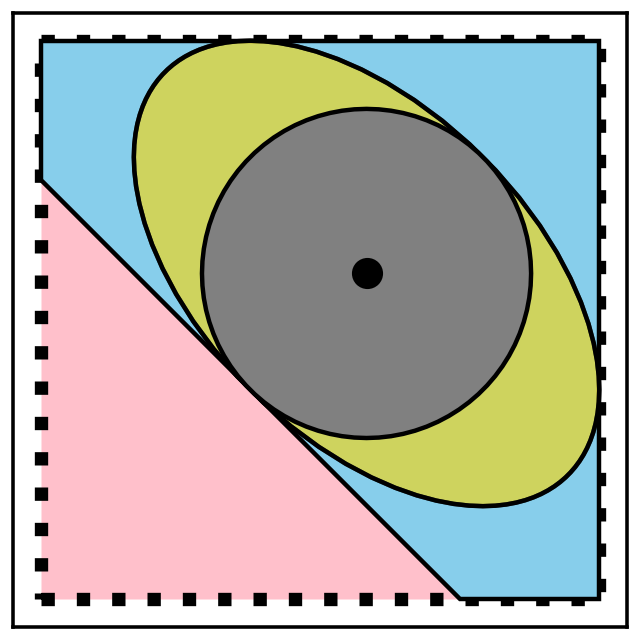pycvxset.common¶
The following functions are few additional methods provided with pycvxset that may be useful to the user.
Estimate area of a two-dimensional set using a grid of given step size |
|
Check if the set is a constrained zonotope |
|
Check if the set is an ellipsoid |
|
Check if the set is a polytope |
|
Filter through the vertices to skip any point that has another point (down in the list) that is close to it in the list. |
|
Spread points on a unit sphere in n-dimensional space. |
- pycvxset.common.approximate_volume_from_grid(set_to_compute_area_for, area_grid_step_size)[source]¶
Estimate area of a two-dimensional set using a grid of given step size
- Parameters:
set_to_compute_area_for (Polytope | ConstrainedZonotope | Ellipsoid) – Set for which area is to be computed
area_grid_step_size (float) – Scalar step size that is constant in both dimensions
- Raises:
ValueError – When set is not 2-dimensional
- Returns:
Approximate area of the set
- Return type:
float
Notes
This function creates a 2D grid of points with a given step size, and computes the fraction of points that lie in the set. Consequently, the computed area is an approximation of the actual area of the set. The area of the bounding box is computed using the
minimum_volume_circumscribing_rectangle()method associated with the set.
- pycvxset.common.is_constrained_zonotope(Q)[source]¶
Check if the set is a constrained zonotope
- Parameters:
Q (object) – Set to check
- Returns:
Returns True if the set is a constrained zonotope, False otherwise
- Return type:
bool
- pycvxset.common.is_ellipsoid(Q)[source]¶
Check if the set is an ellipsoid
- Parameters:
Q (object) – Set to check
- Returns:
Returns True if the set is an ellipsoid, False otherwise
- Return type:
bool
- pycvxset.common.is_polytope(Q)[source]¶
Check if the set is a polytope
- Parameters:
Q (object) – Set to check
- Returns:
Returns True if the set is a polytope, False otherwise
- Return type:
bool
- pycvxset.common.prune_and_round_vertices(V, decimal_precision=3)[source]¶
Filter through the vertices to skip any point that has another point (down in the list) that is close to it in the list.
- Parameters:
V (array_like) – Matrix of vertices (N times self.dim)
decimal_precision (int, optional) – The decimal precision for rounding the vertices. Defaults to PLOTTING_DECIMAL_PRECISION_CDD from pycvxset.common.constants.
- Returns:
The pruned and rounded array of vertices.
- Return type:
numpy.ndarray
- pycvxset.common.spread_points_on_a_unit_sphere(n_dim, n_points=None, cvxpy_socp_args=None, verbose=False)[source]¶
Spread points on a unit sphere in n-dimensional space.
- Parameters:
n_dim (int) – The dimension of the sphere.
n_points (int) – The number of points to be spread on the unit sphere. Defaults to None, in which case, we choose
= (n_points)
cvxpy_socp_args (dict) – Additional arguments to be passed to the CVXPY solver. Defaults to None, in which case the function uses DEFAULT_CVXPY_ARGS_SOCP from pycvxset.common.constants.
verbose (bool, optional) – Whether to print verbose output. Defaults to False.
- Returns:
- A tuple containing three items:
# opt_locations (ndarray): The spread points on the unit sphere. # minimum_separation (float): The minimum separation between the points. # opt_locations_first_quad (ndarray): The spread points in the first quadrant.
- Return type:
tuple
- Raises:
ValueError – If n_points is less than 2 * n_dim.
UserWarning – If n_points - 2 * n_dim is not a multiple of 2^n_dim.
NotImplementedError – Unable to solve the convexified problem using CVXPY
NotImplementedError – Convex-concave procedure did not converge!
Notes
This function uses the CVXPY library to solve a convex optimization problem to spread the points on the unit sphere. The spread points are returned as opt_locations, the separation between the points is returned as separation, and the spread points in the first quadrant are returned as opt_locations_first_quad.
For n_dim in [1, 2], the points are available in closed-form. For n_dim >= 3, we solve the following non-convex optimization problem using convex-concave procedure:
\[\begin{split}\begin{array}{rlrl} \text{maximize} &\quad R \\ \text{subject to} &\quad R \geq 0\\ &\quad x \geq R/2\\ &\quad \|x_i - x_j\| \geq R, && 1 \leq i < j \leq n_\text{points}\\ &\quad \|x_i - e_j\| \geq R, && 1 \leq i \leq n_\text{points}, 1 \leq j \leq n_\text{dim}\\ &\quad \|x_i \| \leq 1, && 1 \leq i \leq n_\text{points}\\ &\quad \|x_i \| \geq 0.8, && 1 \leq i \leq n_\text{points}\\ \end{array}\end{split}\]The optimization problem seeks to spread points (apart from the standard axes) in the first quadrant so that their pairwise separation is maximized, while they have a norm close to 1. The second constraint is motivated to ensure that the reflections of the points about the quadrant plane is also separated by R.
